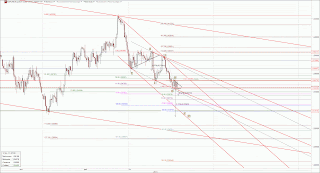Implication
A Descending Continuation Triangle is considered a bearish signal, indicating that the current
downtrend may continue.
A Descending Continuation Triangle features two converging trendlines. The bottom trendline ishorizontal and the top trendline slopes downward. The pattern illustrates lows occurring at a constantprice level, with highs moving constantly lower. The pattern displays two highs touching the uppertrendline and two lows touching the lower trendline.
This pattern is confirmed when the price breaks out of the triangle formation to close below the lowertrendline.
Volume is an important factor to consider. Typically, volume follows a reliable pattern: volume shoulddiminish as the price swings back and forth between an increasingly narrow range of highs and lows.However, when breakout occurs, there should be a noticeable increase in volume. If this volume pictureis not clear, investors should be cautious about decisions made based on this pattern.
Important Characteristics
Following are important characteristics about this pattern.
Occurrence of a Breakout
Technical analysts pay close attention to how long the Triangle takes to develop to its apex. The generalrule is that prices should break out - clearly penetrate the lower trendline - somewhere between threequartersand two-thirds of the horizontal width of the formation. The break out, in other words, shouldoccur well before the pattern reaches the apex of the Triangle. The closer the breakout occurs to theapex the less reliable the formation.
Duration of the Triangle
The Triangle is a relatively short-term pattern. It may take from one to three months to form.
Shape of Descending Triangle
The horizontal bottom trendline need not be completely horizontal.
Volume
Investors should see volume decreasing as the pattern progresses toward the apex of the Triangle. Atbreakout, however, there should be a noticeable increase in volume.
Trading Considerations
Duration of Pattern
Consider the duration of the pattern and its relationship to your trading time horizons. The duration of thepattern is considered to be an indicator of the duration of the influence of this pattern. The longer thepattern the longer it will take for the price to reach its target. The shorter the pattern the sooner the pricemoves. If you are considering a short-term trading opportunity, look for a pattern with a short duration. Ifyou are considering a longer-term trading opportunity, look for a pattern with a longer duration.
Target Price
The target price provides an important indication about the potential price move that this patternindicates. Consider whether the target price for this pattern is sufficient to provide adequate returns afteryour costs (such as commissions) have been taken into account. A good rule of thumb is that the targetprice must indicate a potential return of greater than 5% before a pattern should be considered useful.However you must consider the current price and the volume of shares you intend to trade. Also, checkthat the target price has not already been achieved.
Inbound Trend
The inbound trend is an important characteristic of the pattern. A shallow inbound trend may indicate aperiod of consolidation before the price move indicated by the pattern begins. Look for an inbound trendthat is longer than the duration of the pattern. A good rule of thumb is that the inbound trend should be atleast 2 times the duration of the pattern.
Criteria That Support
Look for a region of support at the bottom trendline and a line of resistance at the highest high of theTriangle.
Moving Average
Compare prices to the 200 day Moving Average. When prices are close to or touch the 200 day MovingAverage this signal is considered stronger.
Volume
A strong volume spike on the day of the pattern confirmation is a strong indicator in support of thepotential for this pattern. The volume spike should be significantly above the average of the volume forthe duration of the pattern. In addition, the volume during the duration of the pattern should be decliningon average.
Criteria That Refute
No Volume Spike on Breakout
The lack of a volume spike on the day of the pattern confirmation is an indication that this pattern maynot be reliable. In addition, if the volume has remained constant, or was increasing, over the duration ofthe pattern, then this pattern should be considered less reliable.
Short Inbound Trend
An inbound trend that is significantly shorter than the pattern duration is an indication that this patternshould be considered less reliable.
Underlying Behavior
This pattern with its increasingly lower highs and constant lows indicates that sellers are moreaggressive than buyers.


Brak komentarzy:
Prześlij komentarz